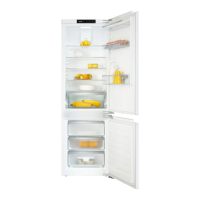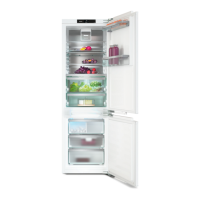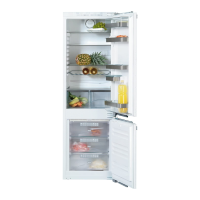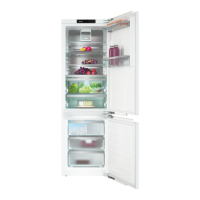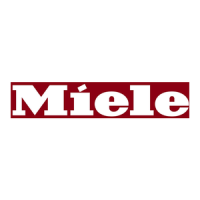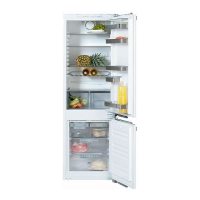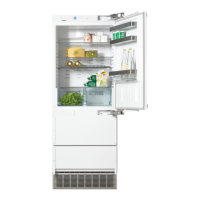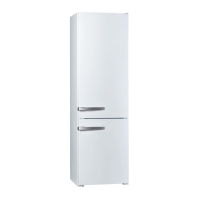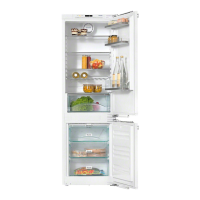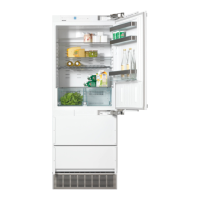Do you have a question about the Miele KFNF 9955 iDE and is the answer not in the manual?
Defines intended use and suitable environments for the appliance.
Safety measures to protect children from appliance hazards.
Details on refrigerant, its properties, and handling precautions.
Emphasizes correct earthing and connection data for electrical safety.
Guidelines for safe connection to mains electricity and power cord maintenance.
Warnings about storing flammable materials and operating electrical equipment inside.
Warnings against steam cleaners, sharp objects, and improper defrosting methods.
Guidelines for safe transport and disposal of old appliances and components.
Identification and function of all controls and indicators on the control panel.
Recommended temperatures for the refrigerator and PerfectFresh zones.
Essential temperature for freezing and long-term storage in the freezer.
Detailed instructions for adjusting temperature settings.
Activating and adjusting SuperCool and SuperFreeze settings.
How to use SuperCool for rapid temperature reduction in the refrigerator.
How to use SuperFreeze for quick freezing of fresh food.
How the appliance warns of high freezer temperatures and potential causes.
How the appliance alerts if a door or drawer is left open.
Advantages of PerfectFresh for freshness, flavor, and vitamins.
How to regulate humidity for dry or humid storage conditions.
Diagnosing and resolving problems with cooling and interior lights.
Identifying causes for the compressor running too often.
Further causes for frequent compressor use and temperature fluctuations.
Diagnosing issues when the appliance temperature rises.
Resolving the buzzer alarm caused by open doors or drawers.
Interpreting power failure symbols and checking food safety after an outage.
Diagnosing alarms for high freezer temperatures and their causes.
Information on fault codes and contacting technical service.
Steps to resolve issues with activating the ice cube maker.
Diagnosing reasons for the ice cube maker not producing ice.
Diagnosing and fixing water leaks from the appliance.
Steps to resolve issues with the appliance's interior lighting.
Information on how to contact Miele for assistance with faults.
Necessary steps and regulations for connecting to the mains water supply.
Step-by-step guide for connecting the water line and power cord safely.
Connecting the water line to the solenoid valve and checking for leaks.
Warnings about installation, grounding, extension cords, and proper plugs.
Appliance voltage, amperage needs, and adherence to regulations.
Emphasis on using qualified electricians for safe connection.
Requirements for outlet accessibility and safe power cord routing.
Warnings against using inverters or energy-saving devices with the appliance.
Requirement to build-in the appliance to prevent tipping.
Required dimensions of the niche for appliance installation.
Detailed measurements of the appliance itself.
Ensuring a stable, level installation and proper appliance alignment.
Keeping doors shut and fitting the anti-tip device for stability.
Detailed steps for securing the anti-tip device to a concrete floor.
Detailed steps for securing the anti-tip device to a wooden floor.
Precautions when inserting the appliance to avoid damaging connections.
Defines intended use and suitable environments for the appliance.
Safety measures to protect children from appliance hazards.
Details on refrigerant, its properties, and handling precautions.
Emphasizes correct earthing and connection data for electrical safety.
Guidelines for safe connection to mains electricity and power cord maintenance.
Warnings about storing flammable materials and operating electrical equipment inside.
Warnings against steam cleaners, sharp objects, and improper defrosting methods.
Guidelines for safe transport and disposal of old appliances and components.
Identification and function of all controls and indicators on the control panel.
Recommended temperatures for the refrigerator and PerfectFresh zones.
Essential temperature for freezing and long-term storage in the freezer.
Detailed instructions for adjusting temperature settings.
Activating and adjusting SuperCool and SuperFreeze settings.
How to use SuperCool for rapid temperature reduction in the refrigerator.
How to use SuperFreeze for quick freezing of fresh food.
How the appliance warns of high freezer temperatures and potential causes.
How the appliance alerts if a door or drawer is left open.
Advantages of PerfectFresh for freshness, flavor, and vitamins.
How to regulate humidity for dry or humid storage conditions.
Diagnosing and resolving problems with cooling and interior lights.
Identifying causes for the compressor running too often.
Further causes for frequent compressor use and temperature fluctuations.
Diagnosing issues when the appliance temperature rises.
Resolving the buzzer alarm caused by open doors or drawers.
Interpreting power failure symbols and checking food safety after an outage.
Diagnosing alarms for high freezer temperatures and their causes.
Information on fault codes and contacting technical service.
Steps to resolve issues with activating the ice cube maker.
Diagnosing reasons for the ice cube maker not producing ice.
Diagnosing and fixing water leaks from the appliance.
Steps to resolve issues with the appliance's interior lighting.
Information on how to contact Miele for assistance with faults.
Necessary steps and regulations for connecting to the mains water supply.
Step-by-step guide for connecting the water line and power cord safely.
Connecting the water line to the solenoid valve and checking for leaks.
Warnings about installation, grounding, extension cords, and proper plugs.
Appliance voltage, amperage needs, and adherence to regulations.
Emphasis on using qualified electricians for safe connection.
Requirements for outlet accessibility and safe power cord routing.
Warnings against using inverters or energy-saving devices with the appliance.
Requirement to build-in the appliance to prevent tipping.
Required dimensions of the niche for appliance installation.
Detailed measurements of the appliance itself.
Ensuring a stable, level installation and proper appliance alignment.
Keeping doors shut and fitting the anti-tip device for stability.
Detailed steps for securing the anti-tip device to a concrete floor.
Detailed steps for securing the anti-tip device to a wooden floor.
Precautions when inserting the appliance to avoid damaging connections.
| Type | Fridge-freezer |
|---|---|
| Appliance placement | Built-in |
| Energy Efficiency Class | A++ |
| Number of Doors | 2 |
| Defrost System | Automatic |
| Noise Level | 38 dB |
| Color | Stainless Steel |
| Door hinge | Right |
| Reversible doors | Yes |
| Built-in display | Yes |
| Display type | LED |
| Lamp type | LED |
| Climate class | SN-T |
| Fridge interior light | Yes |
| Number of vegetable drawers | 2 |
| Storage time during power failure | 24 hours |
| Number of freezer drawers | 4 |
| Star rating | 4 |
| No Frost (freezer) | Yes |
| No Frost (fridge) | Yes |
| Fresh zone compartment | Yes |
| Depth | 550 mm |
| Ice Maker | No |
| Water Dispenser | No |
| Temperature Zones | 2 |
| Total net capacity | 541 L |
